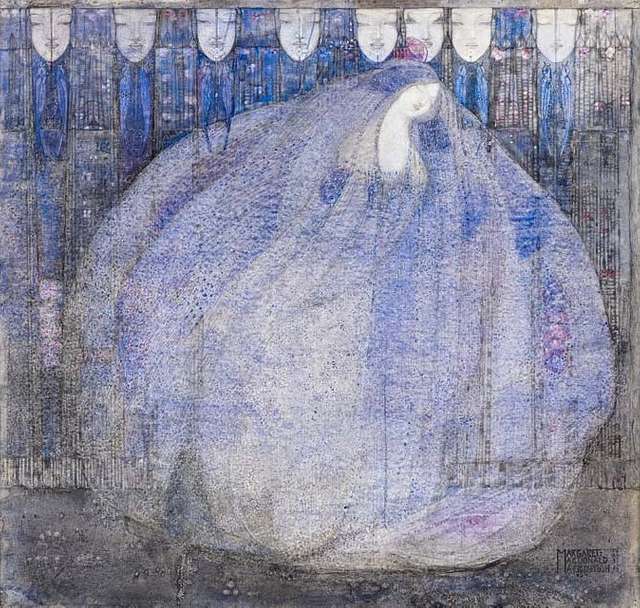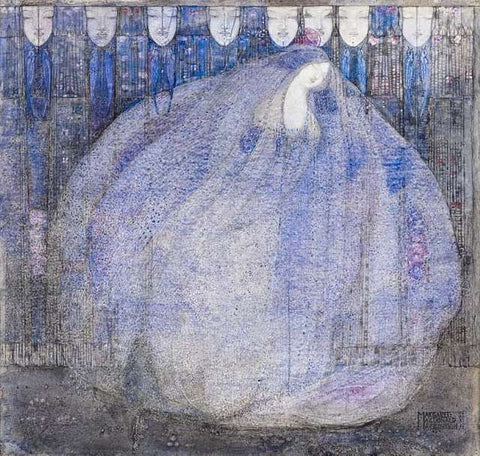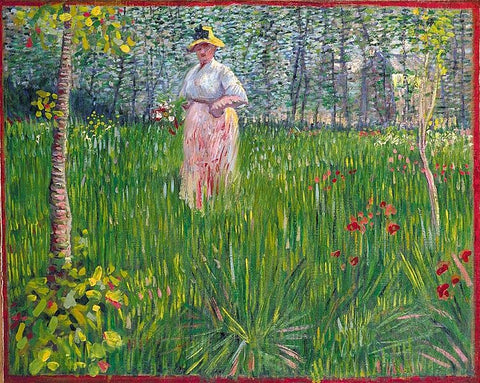Tu carrito está vacío
Free Shipping on orders $499+
Proudly Made In Massachusetts! ![]()
Free Shipping on orders $499+
Proudly Made In Massachusetts! ![]()

One of the great things about the Samsung Frame TV is that you can put up displays of your photos and artwork of almost anything, any painting or photo that catches your fancy. And you can find just about anything.
Samsung has its own art marketplace, where you can buy super high-res versions of your favorite photos and paintings and basically make your own art gallery. This is a good way to take advantage of Samsung's high-resolution screens. But of course, it doesn't have every painting by every artist throughout history, and there may be one or two lesser-known artists you'd like to see hanging on your living room walls, framed by a gorgeous Deco TV Frame.
And, assuming their paintings are in the public domain, there are ways you can download them and install them on your own Samsung Frame TV. Here are underrated artists and artworks you can add to your frame TV art collection.
Some of them are lesser-known artists and some are lesser-known works by well-known artists. But regardless of who they are and what they made, these are some paintings you would love to have hanging in your home museum.
Margaret Macdonald Mackintosh was a Scottish painter who created "The Mysterious Garden" in 1911. The painting currently hangs in the Scottish National Gallery of Art. It is made with watercolor and ink over pencil on a vellum mounted to a board.
 Margaret and her husband Charles Rennie Mackintosh were two key figures in the "Glasgow Style" of art that sprang forth in the 1890s. Glasgow Style was created by around 75 designers who operated in and around the Glasgow, Scotland area. The style wasn't just limited to painting — other mediums included metal, wood, ceramics, stained glass, and interior designs.
Margaret and her husband Charles Rennie Mackintosh were two key figures in the "Glasgow Style" of art that sprang forth in the 1890s. Glasgow Style was created by around 75 designers who operated in and around the Glasgow, Scotland area. The style wasn't just limited to painting — other mediums included metal, wood, ceramics, stained glass, and interior designs.
The Mysterious Garden shows a group of eight masked faces standing at the top of the canvas with bluebird-like creatures underneath the faces, draped like scarves, while in the foreground, another woman sleeps, possibly dreaming of the scene above her.
"The Mysterious Garden" doesn't tell a story in the way some other paintings do, or portray a slice of life, like, say, A Sunday Afternoon on the Island of La Grande Jatte by Georges Seurat. The viewer is left to interpret the message of Margaret Macdonald's work on their own, seeing the things they want to see.
To choose a frame for "The Mysterious Garden" by Margaret Macdonald Mackintosh (1911) on your Samsung Frame TV, consider these key characteristics:
 We're cheating a bit with this one because Vincent Van Gogh is a world-famous artist and some of his paintings are considered the world's greatest. But we wanted to highlight Woman Walking In a Garden because very few people even know it exists.
We're cheating a bit with this one because Vincent Van Gogh is a world-famous artist and some of his paintings are considered the world's greatest. But we wanted to highlight Woman Walking In a Garden because very few people even know it exists.
So little is known, in fact, that the Wikipedia entry only has 38 words on the subject:
A Woman Walking in a Garden was painted by Vincent van Gogh in 1887. As the title indicates, it depicts a woman walking through a garden. Greenery is everywhere and numerous trees can be seen in the background.
We don't even know who she is. Van Gogh often left clues about his subjects in his letters to family, but he never mentioned her. That's because he lived with his brother Theo in 1887, the recipient of most of his letters, which means he never needed to tell anyone else about his mystery woman.
Most of Van Gogh's work is rather sad and melancholy, but Woman Walking In a Garden is an exception. Unlike most of his portraits, this one focuses more on the garden and not the woman herself. Van Gogh used his swirling brushstrokes with bright yellows, blues, and greens to make the garden feel alive. But the woman is painted more loosely than the scenery — we get more details about it rather than her.
This makes us focus on the garden where the color and brushwork tell most of the story and uses more bright colors, which is a departure from his later, more melancholy works.
For Van Gogh's "Woman Walking in a Garden" (1887), selecting a frame for your Samsung Frame TV involves considering characteristics that complement the artwork’s vibrant colors and dynamic brushstrokes:

Czech painter Alphonse Mucha is known for his theatrical posters and advertisers, but it's his "Slav Epic" that makes him one of the greatest historical painters of the 20th century. And, after years of controversy and hiding, The Slav Epic is considered a national treasure in the Czech Republic.
The Epic is a series of 20 enormous paintings — some over six meters high — in the Art Nouveau style. The series reads like a giant comic book, telling the story of the Czech and Slavic people through historical events (After the Battle of Grunwald) and Slavic mythology (The Celebration of Svantovit). He saw the works as a way to unite Slavic people through their shared history.
Mucha's paintings, like much of his work, were done in the Art Nouveau style, with flowing lines and decorative elements inspired by nature. His goal was to evoke emotions in the viewers, celebrating victory and cultural richness in some scenes while depicting struggles and hardships.
Mucha worked on the entire project from 1910 through 1928, and he donated it to the city of Prague as long as the city would build a special pavilion to display it. However, Alphonse Mucha died from pneumonia, shortly before the outbreak of World War II. During the war, his masterpieces were hidden away to prevent seizure by the Nazis.
For Alphonse Mucha's "The Slav Epic" (1910–1928), selecting a frame for your Samsung Frame TV involves considering characteristics that complement the artwork's grand scale, intricate details, and Art Nouveau style:

Paul Delaroche painted The Young Martyr in 1853, followed by a second version in 1855. The first version hangs in The Hermitage Museum in Saint Petersburg, Russia, while the second version hangs in the Louvre. The second version is much darker and harder to see the details, but the 1853 version is clearer and easier to see.
It is an oil painting based on the Romantic style of genre painting (a style of painting that depicts ordinary people engaged in common activities; the figures have no known identity, unlike historical paintings).
The painting depicts the suffering of a young Christian woman floating dead in the water. Her hands are crossed, and a halo floats over her head. There is a boat on the shore, and in the background, a man embraces a woman, and they appear to be saddened at what they have found.
The painting is believed to be an ode to Delaroche's wife, Louise Vernet, who had passed away around this time, but it could also represent the countless Christians who were martyred throughout history, especially during the persecution of Christians under the Roman emperor Diocletian.
(Interesting side note: In the Sherlock Holmes story, Adventure of the Greek Interpreter, Holmes mentions that his grandmother was "a sister of Vernet, the French artist," which refers to Émile Jean-Horace Vernet. Louise Vernet was Horace's daughter, which would have made Holmes her first cousin, once removed.)
For Paul Delaroche's "The Young Martyr" (1853), selecting a frame for your Samsung Frame TV involves considering characteristics that complement the painting's emotional depth, historical context, and delicate details:

Francisco Padilla Ortiz was a Spanish painter well-known for his historical scenes, and he painted more than 1,000 works in his lifetime (1848 – 1921). In addition to the historical paintings, he also painted landscapes, portraits, and genre paintings.
In his painting, Doña Juana La Loca (Queen Joanna the Mad), Padilla shows Queen Joanna I of Castile in grief, holding vigil over the coffin of her late husband, Philip the Handsome (Philip I of Castile). The painting is on display at the Prado Museum in Madrid, Spain. The painting was so successful that several copies were made after it was unveiled.
Padilla was only 29 when he painted this, and it led to his international fame. It tells the story of Joana of Castile who faced great sadness in her life.
Joanna is dressed in black clothing — you might mistake her for a nun — and she is pale with grief, as she stands rigid next to a coffin draped in a golden cloth. The coffin most likely holds her husband, Philip the Handsome, who died at 28 years of age in 1506.
There's not a lot of background, although several other people are standing or sitting nearby. It's said that Queen Joanna had Philip's casket taken everywhere with her, believing one day that he would awaken. So the courtiers gathered around her look bored and tired as if they're used to this constant ritual and waiting.
For Francisco Padilla Ortiz's "Queen Joanna the Mad" (1877), selecting a frame for your Samsung Frame TV involves considering characteristics that enhance the painting's dramatic intensity, historical significance, and detailed realism:
If you would like to learn more about different Samsung frame art, unsung artists, or lesser-known paintings to display in your living room, check out the Samsung Art Store on your Samsung Frame TV. It has more than 2,000 different paintings available from all around the world. And if they don't have something you like, you can always install a painting from another source. Just check out our blog article about How to Add Your Art or Photos to the Samsung Frame TV.
Picking an artwork to display on your Samsung Frame TV screen involves a few simple steps to ensure the piece looks great on the screen and suits your aesthetic preferences. Here are the basic steps:
By following these steps, you can effectively select and display beautiful artwork on your Samsung Frame TV, transforming it into a versatile and dynamic piece of home decor.







